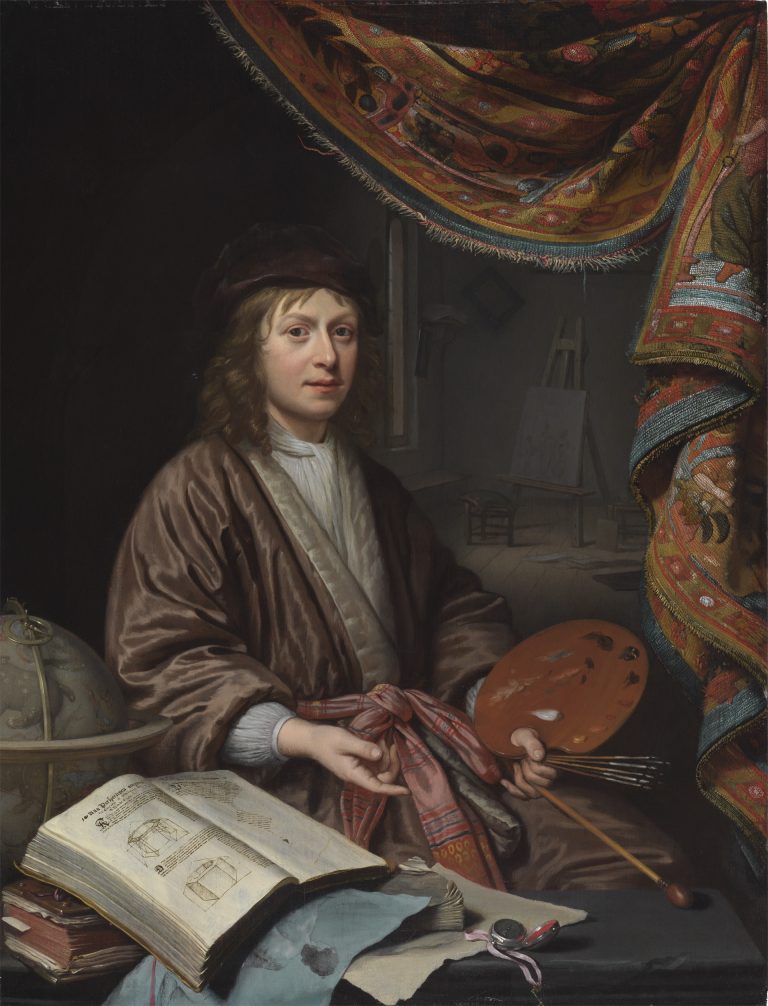The young Michiel van Musscher sits in his workshop and looks straight at the viewer with supreme self-confidence. He is fashionably dressed in a brown velvet beret and a purplish brown, satin Japonse rok tied around his waist with a pink, patterned silk scarf.1 His eyebrows are slightly raised and his lips are parted, as though he is preparing to engage in conversation with us. In his right hand he holds a palette, brushes, and a mahlstick, whereas his left hand is partially raised in a rhetorical gesture, directing the viewer to an exquisite display of objects on a narrow stone ledge in front of him: an open watch attached to a pink ribbon, a blue sheet of paper partially revealing a washed drawing of a female nude, a tattered sketchbook, an open book with geometrical drawings resting on a large, closed book, and a celestial globe. In the background, in an opening framed by the figure on the left and a rich tapestry hanging on the right, is an easel standing by a window and containing an unfinished painting with three figures.
This early painting by Van Musscher is executed with an astounding level of detail, and foreshadows the artist’s interest in depicting different fabrics, which would come to full development in his late career. Van Musscher achieved the glistening quality of the satin rok, possibly the actual “paerse sautijne Japonse Rock” listed in Van Musscher’s posthumous 1705 inventory,2 by applying highlights along the folds of the garment with a thick brush (fig 1), and by offsetting the rok against the finely painted bare floorboards behind him. He also achieved a remarkable realism in the tapestry, especially in the extraordinary detail of the slightly frayed edges, by alternating short, opaque brushstrokes with tiny dots to simulate the weave pattern (fig 2). The care Van Musscher took to depict his objects down to the most minute details is particularly evident in the open book, which has been identified as two pages from the 1555 Dutch edition of Sebastiano Serlio’s (1475–1554) famous treatise Tutte l’opere d’architecttura et prospetiva. These pages explain how to draw an octagonal shape in perspective (fig 3).3 The globe showing a hint of the star sign Ursa Major has been executed with such precision that it has been identified as the celestial globe engraved by Pieter van den Keere (1571–ca. 1646) after a design by the Dutch astronomer and cartographer Petrus Plancius (1552–1622) of around 1625 (fig 4).4
Although the painting is unsigned and undated, an old and now illegible inscription on the back of the panel once read: Pinxit 1673 [or 1683].5 Around 1932 this work was attributed to Van Musscher on an RKD (Rijksbureau voor Kunsthistorische Documentatie/Netherlands Institute for Art History) photo mount, an attribution that was generally, though not unanimously, adopted in the literature.6 It does seem certain, however, that Van Musscher painted this self-portrait. The figure’s facial features, especially the prominent, straight nose and almond-shaped eyes, are consistent with those in the artist’s signed self-portraits, as, for instance, his 1679 Self-Portrait in Rotterdam (fig 5) and his 1685 Self-Portrait in Amsterdam (fig 6). Moreover, Serlio’s book and Plancius’s celestial globe also appear in Van Musscher’s Rotterdam painting.7 Finally, the execution of the painting is consistent with that seen in Van Musscher’s other works. The handling of the shimmering silk and the almost porcelain-like flesh tones, for example, are comparable to those in Van Musscher’s 1687 pendant portraits of Pieter Ranst Valckenier and Eva Suzanna Pellicorne, (see MM-102.a–b).
If, as seems probable, Van Musscher indeed executed this painting in 1673, he would have been at that time 28 years old. He was just starting his successful career as one of the most important portraitists in Amsterdam.8 It has been suggested that the young artist created this painting to showcase his abilities as a portraitist and as a craftsman who could realistically render the materials and textures of the world around him.9 In doing so, Van Musscher apparently took as his model one of Gerrit Dou’s most famous and important self-portraits, which the Leiden master had painted some eight years earlier in ca. 1665 (fig 7).10 The two compositions are remarkably similar, especially the postures of the artists, the manner in which they hold their palettes, and the views into the studio with its easel. In each work, moreover, a tapestry is elegantly draped from the upper edge of the composition. The two paintings are also thematically related; neither artist is dressed in a painter’s smock, but rather in an upper-class wardrobe that suggests his erudition: Dou in the fur tabbaard worn by scholars in his day, and the younger Van Musscher in a modern, fashionable rok.11 This theme of the intellectual artist is reinforced in both paintings by the presence of the globe and the books. At the same time, by including an open watch Van Musscher was also touching upon the concept of vanitas, he was perhaps hinting that his art will triumph over his own mortality.12
The fact that the book and the globe in this self-portrait are identifiable sets this work apart from Dou’s self-representations. The Leiden master depicted books and globes generically for their symbolic value. By specifically including Serlio’s book and Plancius’s celestial globe, Van Musscher asserted the full range of his artistic expertise, which included a command of perspective and an ability to render abstract concepts. The drawing directly under the book emphasizes his skills as a draughtsman. The ultimate testimony to Van Musscher’s talents is, however, provided by the actual painting’s beautiful execution, which is every bit as impressive as the expertise suggested by the painted objects.
